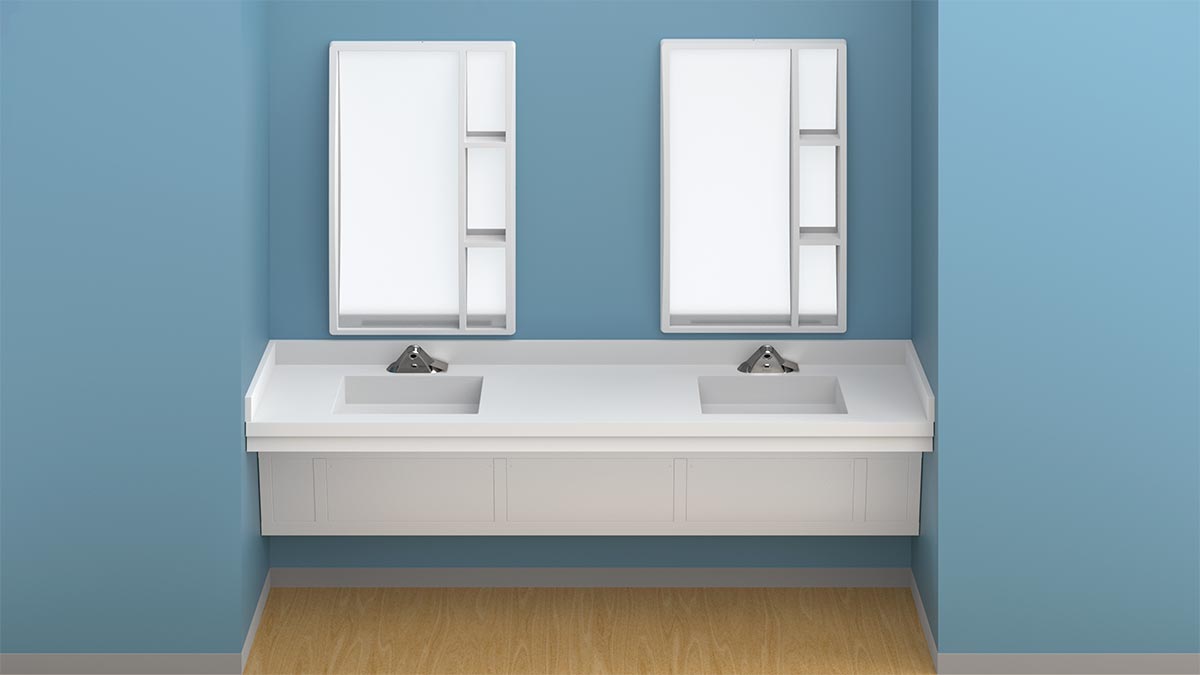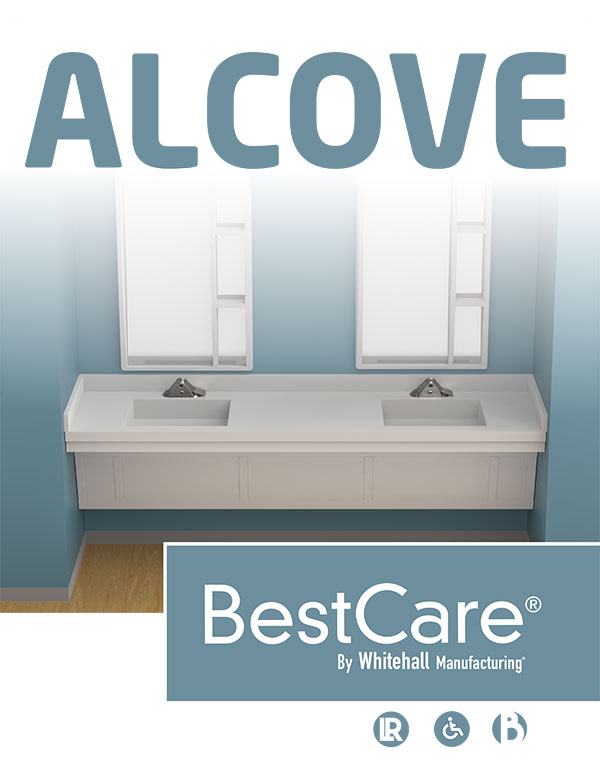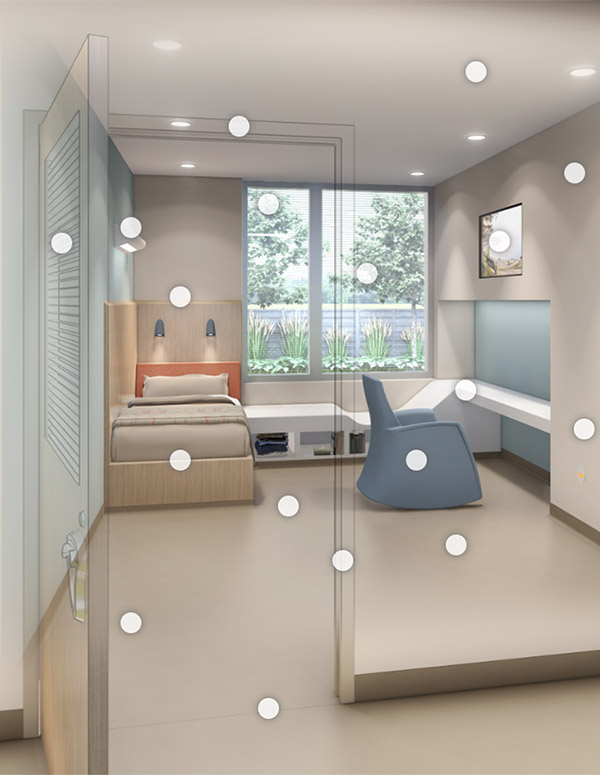
In our usual newsletter, our focus revolves around presenting in-depth profiles of architects, designers, or managers of behavioral health facilities.
However, during a recent company gathering, a compelling notion emerged: the abundance of knowledge and experience within our team. This led us to consider using this space, on this occasion, to delve into the lessons we’ve garnered over the years while witnessing the remarkable evolution of behavioral health.
Whitehall has been committed to helping healthcare practitioners provide effective treatment to their patients since its founding in 1946 by Sal Zaita. Whitehall began by manufacturing whirlpools for the rehabilitation and recovery of soldiers returning home from World War II. Over the years, our product line has expanded to meet the evolving needs of healthcare facilities and the patients they serve, but our core mission remains the same: to help people recover, both physically and mentally.
Kristin Kahle, President of Whitehall Manufacturing, explained, “We’ve come full circle with our BestCare® line expanding that help to include mental health products to not only veterans, but the population as a whole.”
Synergizing Form & Function: The Power of Harmonious Design
In the nascent stages of this transformation, there was a lack of harmony among facilities. Many manufacturers struggled to keep pace with research on health outcomes and the pivotal role of design within them. Kahle likened the spaces to Rube Goldberg machines—a jumble of mismatched design and functionality.
“Harmonizing design and function is imperative,” emphasized Kahle.
For instance, one of our recent innovations involves ligature-resistant BestCare faucets. Facilities now understand that empowering patients with safety-aligned autonomy is crucial for their recovery. This autonomy translates to patients being able to use cold water for brushing their teeth and warm water for washing their face. Our latest ligature-resistant faucets feature dual sensors, granting users access to cold, tempered, or both water options.
So, how does Whitehall manage to adapt swiftly to the market? Three critical factors contribute: the proficiency and experience of our team, our status as a true manufacturer, and the relationships we’ve cultivated over the years.
“At Whitehall, everyone possesses expertise and experience, yet they’re all aware of the evolving industry and they take it upon themselves to learn and grow with it. Our sales engineering, customer service, and field service departments have all received resoundingly positive feedback,” Kahle remarked. “Furthermore, we’re extremely receptive to our clients’ suggestions. Our clients know we have the resources to make the changes they want.”
Empowering Innovation: Our In-House Design, Engineering & Manufacturing Advantage
This brings us to the second success factor, which is in our manufacturing. Whitehall is a true manufacturer, meaning we design, engineer and manufacture all our products in-house.
“We create these products because we care,” said Milene Koblasa, Whitehall National Sales Manager for the Western United States. “Behavioral healthcare understanding has changed rapidly, and the industry now recognizes the impact that design has on the emotional and psychological healing process. We’ve always had a handle on the plumbing side, but we now understand that function is not where we stop. We must consider design as much as safety and function.”
Koblasa brings that design knowledge to our company. She worked for MGI 25 years ago and then left to design custom homes for 11 years. Now she is back and using that experience to inform the design of our products.
“All those design aspects that make a house a home—ergonomics, environmental influences, natural light—they are the same improvements that behavioral health facilities are looking for,” said Koblasa.
Our approach isn’t limited to merely modifying a few healthcare items for the behavioral health market. We built our BestCare line from the ground up, specifically designed to meet the unique needs of behavioral healthcare facilities and their patients.

As an example, the shift toward individual patient rooms prompted us to concentrate on crafting plumbing fixtures and accessories tailored for single rooms. However, we swiftly realized that some facilities mandated dual occupancy setups. Responding swiftly, we introduced a dual alcove sink option that can be tailored to specific dimensions. Our ability to design, engineer, and manufacture products in-house affords us a distinct edge. Unlike companies manufacturing overseas or white-labeling products, we retain complete control over our product decisions, heavily influenced by market demands.
“Collaboration is one of our strong suits, and we’re adept at generating ideas to solve our customers’ challenges,” Kahle affirmed. “We receive numerous requests for modifications or changes, and we’re well-equipped to assist. Our competitors often lack this capability due to their non-manufacturing status and the dearth of in-house expertise and resources that we possess.”
Another aspect that sets us apart is Whitehall’s exclusive focus on manufacturing healthcare products, in contrast to other companies engaged in multiple sectors. While our parent company, Morris Group International, spans diverse verticals, Whitehall’s singular focus on healthcare deepens our comprehension of behavioral and mental health needs. As our insights into patient and facility requirements grow, our emphasis pivots to the provision of essential products, facilitating effective treatment and compassionate care. The goal is to help prevent inpatient suicides and foster a nurturing environment.
So, how did we attain this knowledge? By securing a seat at the table and actively participating in the broader discourse.
Driving Change: Our Role at the Forefront of Industry Discussions
The initiative to secure this seat was led by Steve McIntosh, Director of National Sales and Healthcare Specialist at Whitehall Manufacturing.
“While researching healthcare-related matters, I stumbled upon the Center for Health Design’s (CHD) website. Whether seeking studies, best practices, or tools in the realm of healthcare, particularly behavioral healthcare, their site consistently emerged as a valuable resource,” shared McIntosh. “We promptly engaged with them to explore how we could contribute as a manufacturer. Our intention extended beyond reaching our target audience; it centered on the immense learning opportunities they presented.”
McIntosh has taken full advantage of learning opportunities and recently received his Evidence-Based Design Accreditation & Certification (EDAC) from the CHD. The EDAC program is an internationally recognized credential that demonstrates an individual’s understanding of how to apply evidence-based design principles to all settings that contribute to health, safety, and well-being.
One significant area of enlightenment for everyone at Whitehall emerged through the concept of Emergency Psychiatry Assessment, Treatment, and Healing (EmPATH) Units, also known as crisis stabilization units. Given the rising trend of emergency departments (EDs) serving as primary points of care for behavioral health concerns, the strain on the system has increased. A substantial portion—12-15 percent—of ED visits pertain to mental health or substance abuse issues, burdening the EDs. These departments often lack the resources necessary for effective treatment, leading to prolonged waits for psychiatric beds. Dr. Scott Zeller, an expert in emergency psychiatry, introduced the EmPATH unit concept to enhance care for such patients.

Further Reading
Interactive Inpatient Rooms
The Center for Health Design has several great interactive inpatient room mock-ups.
They include a large body of research evidence and best practice knowledge for designers to draw upon in order to successfully address each project’s unique issues.
According to Vituity, “EmPATH’s goal is to achieve better outcomes by getting patients immediately in front of a psychiatrist and commencing treatment in a comfortable setting, with an involved, interactive staff and regular opportunities for reassessment.”
“This marked a substantial shift from what we observed in the healthcare arena for decades. Preceding the EmPATH notion, EDs did their best by creating rooms or spaces that were as ligature-resistant as possible—an almost unattainable feat,” noted Russell Gibson, national sales manager at Whitehall Manufacturing. “EmPATH units and clinics prioritize aesthetics, and our BestCare line embraces this aesthetic element while still elevating safety.”
Our involvement in organizations like the Center for Health Design, among others, has deepened our understanding of the lingering gaps in the behavioral health market.
Despite substantial efforts to achieve parity between mental and physical health treatment, behavioral health still doesn’t receive the same acknowledgment or equal treatment. Insurance coverage, in particular, remains unequal. Many insurance plans hesitate to cover mental health treatment, with some even disputing coverage in its entirety. For instance, caps on inpatient days are common for behavioral health patients but not for acute care patients.
This imbalance contributes to the chronic shortage of beds in behavioral health units, leading to a backlog in general hospitals as patients await transfers. Consequently, patients are caught in limbo, awaiting proper care.
Although the Parity Act from the mid-90s aimed to address these discrepancies and has been federal law for over 25 years, true parity remains elusive. The core issue lies in the lack of parity in both treatment and financial support within healthcare.
Engaging with providers, architects, designers, experts, and fellow manufacturers has offered us insights into the struggle stemming from this financial disparity. While we, as manufacturers, could enhance products significantly, the feasibility of these improvements is often hampered by cost considerations.
One avenue to lower costs without compromising quality that we’ve explored is integrating diverse materials wherever possible.
“We’ve notably softened our BestCare line, offering a range of designs. We understand that these products needn’t resemble institutional fixtures. Presently, we’re actively leveraging our injection molding capabilities within MGI and moving away from the exclusive use of stainless steel,” Gibson shared. “While stainless steel has its advantages and can be aesthetically appealing through powder coating, certain applications call for a different approach. For example, our stainless steel towel hook had a very institutional appearance that didn’t align with contemporary environments. We’ve replaced it with a sleek, injection-molded plastic hook that maintains ligature resistance while resembling a feature found in a hotel room. It’s simple, elegant, and—importantly—easy to clean.”

Further Reading
EmPATH Units
Dr. Scott Zeller pioneered the idea of EmPATH units.
For his contributions, the California Hospital Association honored him with the 2019 Ritz E. Heerman Memorial Award.
In addition, Healthcare Design magazine recognized him as one of 2020’s “Top 10 People in Healthcare Design.”
Illuminating the Unseen: Unveiling the Unexplored Options
Despite the availability of excellent products fitting the prevailing calming and non-institutional design trend, there’s still a prevalence of correctional-style products without meaningful modification throughout facilities. This raises the question: Why?
“Recently, a facility’s life safety coordinator visited our trade show booth and, upon inspecting our products, exclaimed, ‘I wasn’t aware such products existed. I had no idea they could be this nice,’” Gibson recounted. “The limited adoption of available products can be attributed to a lack of awareness among facility staff. This individual was genuinely amazed and expressed a desire for his team to explore the options available when it came time for renovation or replacement. Our demonstration trailer is instrumental in this regard, enabling us to showcase products directly to facilities, architects, and designers, offering them not just visual exposure but hands-on experience.” Whitehall offers products that are extremely renovation-friendly and cater to diverse budget ranges. Whether you are a top-of-the-line privately funded facility, a state or Veterans Administration (VA) facility with a tight budget, or a community hospital with non-profit funding, we are poised to help create aesthetically pleasing and safe spaces.
Whitehall can also match rough-ins for older installations, making it possible to replace fixtures without having to open walls. This is especially beneficial in the densely populated Northeast U.S., where facilities often do not have the space to expand or build new facilities. As a result, facilities in this region must remodel while also facing the same bed shortage crisis as the rest of the country.
“We worked with a facility in Nassau County, Long Island, that told us that they were at maximum capacity and they didn’t have any extra rooms. Worries of asbestos discovery within walls meant a simple toilet swap could escalate into protracted abatement efforts,” McIntosh disclosed. “Since we could replicate their diverse rough-in requirements, this became a non-issue.”
Lastly, the concept of universal design merits attention. The onset of COVID exposed the unpreparedness of numerous healthcare facilities, underscoring the need for spaces capable of caring for anyone and everyone. This entails rooms accommodating ADA, bariatric, and behavioral health patients. While most facilities move towards ADA-compatible rooms, we propose going a step further—designing rooms that can cater to all patient needs.
Ligature-resistant products that embrace an inviting and non-institutional appearance, coupled with minor modifications, can cater to bariatric requirement
Guided by Innovation, Fueled by Purpose: Whitehall’s Unwavering Commitment to a Healthier Future
Our journey over the past 25 or so years serving the healthcare sector has been transformative. Since Whitehall’s founding 77 years ago, we are still making whirlpools and cold tanks used for rehabilitation. However, as Dutch Schmitt, Whitehall’s general manager, points out, “Even they have evolved. The FDA now has manufacturing guidelines for hydrotherapy tools that we adhere to. In addition, we are also evolving with the science and have partnered with Bimini to incorporate their NanoJet Oxygen Perfusion System, which adds a perfusion of oxygen into the body’s soft cell tissue using Ultra Fine Bubbles (nano bubbles).”
Kahle, in summarizing Whitehall’s transformation said, “We remain committed to learning from and collaborating with our customers and hope they’ll continue relying on our expertise as well,” said Kahle. “Nearly everyone has been touched by general and behavioral health concerns. While some of the stigma around mental health has eroded, there’s still a long road ahead. Achieving parity remains a challenge, requiring collective efforts from government, non-profits, facilities, architects, designers, and manufacturers—all with the patient’s well-being in mind. Together, we might just achieve something remarkable.”
Expand Your Knowledge
Free CEU Credits
Whitehall offers five continuing education courses specifically for the healthcare market.
Available online via AEC Daily, all are free and completely self-paced.

